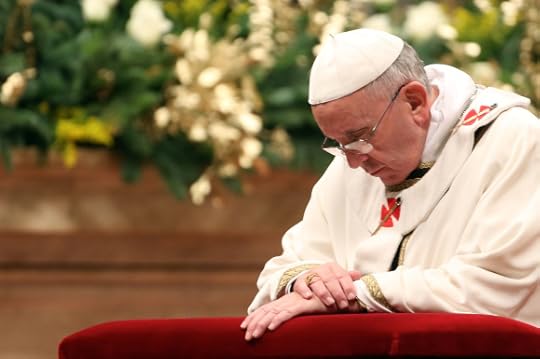Andrew Sullivan's Blog, page 401
December 25, 2013
A Christmas Copycat?
When Dickens visited Massachusetts in 1842, he paid a visit to the Lowell textile mill, whose workers – and their monthly literary journal, The Lowell Offering – made quite an impression on him. Recently, literary scholars have suggested that Dickens may have even borrowed from journal for his classic “A Christmas Carol,” published 18 months after his visit:
The real emotional power of “A Christmas Carol,” and the reason we return to it year after year, is its message of redemption: in a single night, Scrooge turns his life around. Here, too, The Lowell Offering offered a precedent. In the essay “Memory and Hope,” written by a mill girl using the pen name Ellen, the narrator is visited by two spirits who offer competing visions of how she could live her life. After they’ve gone, the narrator promises to “never again covet the garland of fame,” but instead to “make myself more useful to my fellow creatures.” Scrooge makes a similarly triumphal statement at the end of “A Christmas Carol,” when he vows to become “as good a friend, as good a master, as good a man, as the old city knew.”
Despite the correspondences, not everyone agrees it’s an airtight case. A recent article about the claim on the Boston University website triggered a conversation on Dickns-L, an internet discussion board popular with Dickens scholars. One commenter posted that the inspiration for “A Christmas Carol” was simply the universally known story of Lazarus, the biblical figure raised from the dead. Another wrote that the seeds of “A Christmas Carol” could be found closer by, in a brief story inserted into “The Pickwick Papers,” which Dickens had written six years before he visited Lowell, and which the mill girls may well have read. … [Boston University professor Natalie] McKnight agrees that story played into “A Christmas Carol,” but says The Lowell Offering much more closely anticipates its tone, structure, and theme.
(Video: a reformed Scrooge, played by Michael Caine, sings in The Muppet Christmas Carol)



Bad Santa
Some background on Krampus:
Krampus, whose name is derived from the German word krampen, meaning claw, is said to be the son of Hel in Norse mythology. The legendary beast also shares characteristics with other scary, demonic creatures in Greek mythology, including satyrs and fauns. The legend is part of a centuries-old Christmas tradition in Germany, where Christmas celebrations begin in early December. Krampus was created as a counterpart to kindly St. Nicholas, who rewarded children with sweets. Krampus, in contrast, would swat “wicked” children and take them away to his lair.
Last December, Collectors Weekly talked to Monte Beauchamp, who published a book of early 1900s Krampus postcards, about the “Christmas devil”:
Collectors Weekly: Why was Krampus so scary?
Beauchamp: He’s like the bogeyman and was created by adults to scare the bejeezus out of wayward children. Every country seems to have their own bogeyman. On December 6, which is St. Nikolaus Day, obedient children would hop out of bed and rush to the empty shoe they’d placed outside the night before to retrieve the small gifts or treats that St. Nikolaus had left for them. In the shoes of disobedient children awaited switches, with which their parents would spank them. Those that had been especially bad were paid a visit by Krampus, who oftentimes would place them in the wooden basket strapped across his back and cart them off to the countryside and terrorize them until they promised to be good.
Collectors Weekly: Is Krampus the devil?
Beauchamp: Though Krampus is perceived as a devil and is referred to as one, he’s mainly a composite of man and beast; he has fur all over his body, and what devil has a tongue like that? He’s also a good-natured character; his only desire is to persuade unruly children to turn from their wicked ways. …
Collectors Weekly: What date does Krampusnacht take place? How do you celebrate?
Beauchamp: On the Eve of St. Nikolaus, which is December 5, in Salzburg, Austria there’s a winter festival known as Krampuslauf—“The Running of the Krampus,” in which young men clad in Krampus costumes are herded into town by a person attired as St. Nikolaus. He then greets the crowd and unleashes the herd of Krampuses, who rattle chains, clang cowbells, brandish birch switches, and terrify the children.
Previous Dish on Krampus here.
(Photo: Members of the Haiminger Krampusgruppe dressed as the Krampus creature parade in the town square during their annual Krampus night in Tyrol on December 1, 2013 in Haiming, Austria. Krampus is a demon-like creature represented by a fearsome, hand-carved wooden mask with animal horns, a suit made from sheep or goat skin, and large cow bells attached to the waist that the wearer rings by running or shaking his hips up and down. Krampus has been a part of Central European, alpine folklore going back at least a millennium and since the 17th-century Krampus traditionally accompanies St. Nicholas and angels on the evening of December 5th to visit households to reward children that have been good while reprimanding those who have not. However, in the last few decades, Tyrol in particular has seen the founding of numerous village Krampus associations with up to 100 members each who parade without St. Nicholas at Krampus events throughout November and early December. By Sean Gallup/Getty Images)



The Seeds Of A Christmas Tradition
Erica R. Hendry tells the story of how the poinsettia – named for the US Ambassador, Joel Roberts Poinsett, who first brought the plant stateside in the 1830s – was popularized as a Christmas flower by the “unheralded Ecke family [which] has more than 500 U.S. plant patents, nearly one-fifth of them for poinsettias”:
The earliest poinsettias were sold by individual florists and merchants—including the
patriarch of the family, Albert Ecke, a German immigrant—and usually as single-cut stems instead of rooted in pots. But they were hardly durable; most would last two or three days, at best. The Eckes helped transition poinsettias from ephemeral flowers to potted plants, created new shapes and introduced new colors (from shades of white and yellow to those that have names, “ice punch,” “pink peppermint” and “strawberries and cream” among them). They’re vastly different from the poinsettias Americans knew a century ago, which were actually quite “scraggly,” says Paul Ecke III, who sold the Ecke Family Ranch in 2012. …
By nature, poinsettias are at their best between November and January, which aligns perfectly with the Christian advent season. For that reason, Paul Sr. started to market the plants as “Christmas flowers.”
“They didn’t really have a holiday to go with them,” Ecke said, as lilies, for instance, are associated with Easter. The name stuck and “that was really his claim to fame,” Ecke said, as the family would go on to push poinsettias across the country; in later years, the family provided poinsettias to the White House and to a number of magazines and television shows (including The Tonight Show).
(Photo of poinsettia “tree” by Alby Headrick)



Lessons From Rudolph
Richard Beck finds wisdom in the Christmas TV specials he watched as a child:
Hermey, Rudolph, and Yukon Cornelius, after being chased by The Abominable Snowman, find the Island of Misfit Toys. This is an island where rejected, unwanted, and unloved toys find sanctuary. Rudolph, sympathetic to the plight of the Misfit Toys, because Rudolph knows what it’s like to be a misfit, promises to take their plight to Santa…. [T]he theology of Rudolph takes its most radical, surprising, and extreme turn when the personification of evil, The Abominable Snowman, comes back from death in a quirky resurrection event–Bumble’s Bounce!–as a peaceable creature who is also in need of loving community. Apparently, this “evil” creature is also a misfit. And the hint is that he’s “abominable” because he’s been marginalized and without community.
So, summarizing all this, I learned from Rudolph this important lesson about Christmas: Something about Christmas means misfits have a place, a community, a home. Or, rephrased, Christmas means that there are no more misfits.
Michael Schaffer is less taken with the story:
Let’s review. There’s this little reindeer with a deformity. We have no evidence that this deformity actually keeps him from his reindeer duties: He has a red, glowing nose. Big deal! It’s not like he has a torn ACL that might limit his flying-sleigh-pulling abilities. At any rate, because of this deformity, the other reindeer laugh, call him names, and bar him from their all-important games, effectively ostracizing him just because he looks funny.
Then, on December 24, the fog rolls in. Santa and the in-crowd are stranded. Without so much as an apology, Rudolph is asked to guide the sleigh. (Or perhaps he isn’t asked: The lyrics specify that Santa “came to say” that Rudolph could guide his sled—I’m guessing no one even inquired as to whether he had other holiday plans.) Despite the repeated snubs and the impolite request, Rudolph demonstrates his utility in brilliant form. At which point all the reindeer decide that they love him. Notice that they still don’t apologize.
Perhaps I am wrong, but this strikes me as a terrible, terrible lesson for kids.



The 2013 Dish Awards: The Dick Morris Award
This 1998 comment from Paul Krugman is currently in the lead for the Dick Morris Award, “given for stunningly wrong political, social and cultural predictions”:
The growth of the Internet will slow drastically [as it] becomes apparent [that] most people have nothing to say to each other…. By 2005 or so, it will become clear that the Internet’s impact on the economy has been no greater than the fax machine’s
Only about five points behind is Paul Ryan, who predicted this September 18, 2013:
Oh, nobody believes [Obama's vows to not negotiate on raising the debt ceiling]. Nobody believes that. He himself negotiated Bowles Simpson on the debt limit with Democrats. That was Kent Conrad’s requirement. He himself negotiated the Budget Control Act with the debt limit. Graham Rudman. Bush Andrews Airforce Base. Clinton Gore ‘97. All of those major budget agreements were debt limit agreements. I see this time as no different and I believe he does too. I think most people believe he’s just posturing for now.
Who was more wrong? Review all the candidates and decide here. Use the links below to vote for the other awards.
Click here to vote for the 2013 Malkin Award!
Click here to vote for the 2013 Moore Award!
Click here to vote for the 2013 Poseur Alert!
Click here to vote for the 2013 Yglesias Award!
Click here to vote for the 2013 Hewitt Award!
Click here to vote for the 2013 Hathos Alert!
Click here to vote for the Chart Of The Year!
Click here to vote for the Cool Ad Of The Year!
Click here to vote for the Face Of The Year!
Click here to vote for the Mental Health Break Of The Year!
Click here to vote for the Window View Of The Year!



Face Of The Day
Pope Francis attends the Christmas night mass at the St. Peter’s Basilica on December 24, 2013. Pope Francis celebrates the first Christmas of his pontificate. By Franco Origlia/Getty Images.



Why Is Christmas On The 25th?
Considering the question last year, Andrew Santella offered a “less well-known explanation for the Dec. 25 date—one with appeal for anyone uncomfortable with a connection between Christmas and the old solstice festivals”:
According to some scholars, Christmas was set near the winter solstice not because of any pagan traditions but based on a series of arcane calendrical computations. This argument hinges on an ancient Jewish tradition that had the great prophets dying on the same dates as their birth or, alternatively, their conception. Thus, to follow this peculiar assumption, the first step in dating Jesus’ birth would be to date his death, which the Gospels say happened at Passover. The early Christian writer Tertullian calculated that the date given for Jesus’ death in John’s Gospel corresponds to March 25 in the Roman calendar. Many Christian churches came to celebrate the Feast of the Annunciation, marking the angel Gabriel’s visit to the Virgin Mary to tell her that she would become the mother of Jesus, on this date. Adding nine months to this date produces a Dec. 25 Christmas. This alternative explanation is sometimes deployed to dismiss the notion that the holiday had pagan roots.



December 24, 2013
How Do You Like Your Lights?
Kelly Faircloth favors multicolored:
At the risk of sounding treacly, there’s just something a little magical about bringing a big, riotous burst of color to a random corner of your living room, or your front porch, or strung across your kitchen window. It changes the whole look of the place. You dim the overhead lights and suddenly it’s all red, green and blue. Doesn’t matter if you’ve got landlord beige walls and Ikea furniture—suddenly it’s like you’re inside that Chip and Dale cartoon where they wreak havoc inside Mickey’s Christmas tree, or that Indian restaurant downtown.
Plus, they’re retro as hell. You can trigger your parents’ nostalgia by lightly evoking your grandparents’ living room, or you can go with those big fat bulbs if you want to deck your tree out in full Mad Men cosplay. It’s fun. It’s festive. It says go ahead, have too many cups of spiked hot chocolate and wear that Santa hat, we’re all friends here.
Kate Dries prefers white:
Even without a tree, white lights are entirely superior beast to their bastard cousin, the multicolored light strand.
White lights give off a soft glow that demands the age-old mantra, “Everyone looks better in the dark,” be updated to “Everyone looks better when lit by white Christmas lights.” There is a reason college students, who are otherwise idiots about decor, use white light strands to decorate their barren dorm rooms: they set an automatic mood of peace and tranquility. Not to mention, white lights are classy as fuck. They work with everything. They let your decorations shine. They look like snow. They look like ice. They look like candles. They look like Christmas.
I grew up in a household where white Christmas lights – which, I like I said, are the only Christmas lights – were treated with a degree of reverence normally reserved for a beloved figurine of the Baby Jesus inherited from a long-dead relative. To watch my mother (and her father before her) put lights on a Christmas tree is akin to watching a great sculptor like Bernini lovingly craft some of his greatest works. It takes hours upon hours. … For this is the Most Holy Part of Christmas.
(Photo by Flickr user Christmas w/a K)



Christmas Hathos Alert
A final submission from a reader:
Holiday specials are a very particular version of hathos, and nothing, absolutely nothing, beats the Star Wars Holiday Special. It ran once only, before George Lucas ensured it will never see the light of day again. However, as always, the Internet delivers. Even the intro is enough to inspire a nearly toxic case of hathos.
All of our Christmas Hathos is here.



What You Shouldn’t Give
Daniel Gross argues that although gift cards can “signify a greater level of thought than cash,” purchasing one is “really making a free loan to big business”:
[L]ots of things could happen that would mean that the full amount of the gift isn’t used. In the retail trade, this is known as “breakage.” Breakage is a feature, not a bug, of the gift-card system, and it’s one of the most pernicious aspects of the trend. When balances aren’t used, they are simply pure profit for the retailer that sold the card. They get money upfront and never have to deliver any goods or services.
Even when recipients do use the full value of gift cards, retailers are still making out like bandits. Even in this age of low interest, idle money has value. When you buy a gift card, you are effectively making an interest-free loan to the company for the period until the card is redeemed – a week, a month, six months, a year. Large companies like Starbucks have very efficient treasury operations that sweep all available cash into interest-earning savings instruments. Cash is a resource like any other, and companies hate to see any resource go to waste.
Other drawbacks of playing it safe:
When we asked the gift givers to rate how much they expected recipients to enjoy the gift, and contrasted this with the actual level of enjoyment of the person getting the gift, we found three systematic biases:
First, gift receivers rated the gifts as more exciting than gift givers; in general, gift givers underestimated how much joy their gifts would bring.
Second, gift receivers preferred the riskier gift and wished that gift givers took more chances.
Finally, the underestimation of how much people would like the gifts was particularly large for risky gifts.



Andrew Sullivan's Blog
- Andrew Sullivan's profile
- 154 followers






